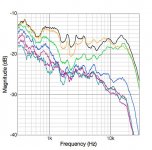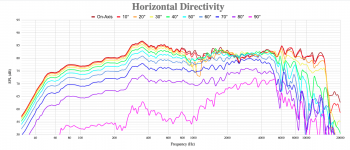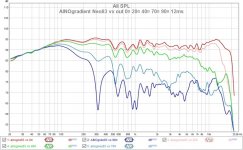What are these "advantages of the sonic strengths of dipole reproduction in homes"the advantages of the sonic strengths of dipole reproduction in homes don't apply to low bass.
Big ESL, Martin Logan or Magnepan are actually not good dipoles, they have VERY problematic dispersion. And as per pics, most owners put them in corners...I've been a keen advocate of dipole ESLs (nearly full range large panels) since early '70s. But.....
the advantages of the sonic strengths of dipole reproduction in homes don't apply to low bass. Nothing is gained by struggling with very large baffles (I had one) or enormous EQ boost with a sub.
While I don't believe in "matching" box types, I think the real sound quality pairing of dipoles is with a large corner horn (Klipschorn).
B.
By the way latest ML have monopole bass with dsp. Test in Stereophile 2016
https://www.stereophile.com/content...-renaissance-esl-15a-loudspeaker-measurements
Last edited:
With the great increase in interest in dipoles these days, must be lots of people who could answer better for me. (Previously, the very idea of open-backed cabs were totally anathema since textbook readers believed the rear wave comes around to destroy the front wave.) Of course, there used to be great interest in tapped "horns", so popularity may not mean much.What are these "advantages of the sonic strengths of dipole reproduction in homes"
Some advantages are (1) not a box and (2) works with the room to create satisfying orchestral sound.
Odd to find Juhazi criticizing the ML dispersion when his link shows excellent dispersion beyond 45-degrees. My music room has only one chair, unfashionable sound absorbing furnishings (like wall to wall carpet with underlayer) and DSP so dispersion (or FR for that matter) isn't a problem for me. For sure, the sound quality in other respects swamps the shortcoming of dispersion front or rear.
B.
I didn't critizice ML, but panels in general. ML is propably the best, being curved
Sorry, measurements below are from different sources, different methods, but all 0-90deg.
Magnepan SLR by ASR - horizontal https://www.audiosciencereview.com/forum/index.php?threads/magnepan-lrs-speaker-review.16068/
and ML by Stereophile
vs. narrow baffle multiway



Sorry, measurements below are from different sources, different methods, but all 0-90deg.
Magnepan SLR by ASR - horizontal https://www.audiosciencereview.com/forum/index.php?threads/magnepan-lrs-speaker-review.16068/
and ML by Stereophile
vs. narrow baffle multiway



Last edited:
As we learn from Toole, dispersion index and total power need to be digested together to understand human perception (also known as "sound quality") in a room. So, while DI for large non-curved panels can't match hypothetical point sources, the total picture to the human listener takes more into account. And dipoles have that "more" and boxes do not.
My large home-brew panels are composed of 6 ESL panels and mounted on a curve. Dayton-Wright argued that that geometry would represent a point source a few feet behind the panel. I don't know if that is correct, but sounds good, eh.
B.
My large home-brew panels are composed of 6 ESL panels and mounted on a curve. Dayton-Wright argued that that geometry would represent a point source a few feet behind the panel. I don't know if that is correct, but sounds good, eh.
B.
+-4db response linearity on-axis and than the same deviation off axis which results in the same dispersion as a 10+ inch cone driver I wouldn't call excellent, not even remotely acceptable imo. If this is excellent for you then what is bad, I cannot imagine it any worse? A pair of Neumann KH120 A, have a response linearity of +-1db and those cost like 600 a piece, so about 20x times less, I would hope that if you spend 20x times as much it gets better not worse, but that may be me...Some advantages are (1) not a box and (2) works with the room to create satisfying orchestral sound.
Odd to find Juhazi criticizing the ML dispersion when his link shows excellent dispersion beyond 45-degrees.
Also absurd comment, I think it is pretty well known here that on and off-axis linearity is a big part of the perceived sound and one cannot just eq direcitivity problems away anyway, even than why buy such an expensive speaker to than have to fix it yourself at home?My music room has only one chair, unfashionable sound absorbing furnishings (like wall to wall carpet with underlayer) and DSP so dispersion (or FR for that matter) isn't a problem for me.
??? By far the number one property of what makes a speaker good audibility wise is frequency response of the on and off axis sound, so I am not sure how you imagined the fact that it is a dipole or panel speaker is going to swamp that huge shortcoming??For sure, the sound quality in other respects swamps the shortcoming of dispersion front or rear.
I love dipole sound for acoustic instruments and vocal - folk and classical recordings usually have nice sound with minimal studio trickery. Jazz and pop from 1950-60's sound good too!
Am I right that you’re saying they are good to great for just about every major genre of music- except rock music?
… if so what aspects make less/ not above average or excellent for rock? And what speaker approach/ es do you think are best?
I think the perception that dipole sound is not that great to rock, because for other genres like folk, jazz, classical, vocal..., you can have real experience with un-amplified performances. While with rock music, the most common references are through rock concerts, which are 100% amplified with PA Amplifier and PA Loudspeakers. So the perception with rock music is generally shaped by the PA loudspeakers, which is monopole in nature with vented bass. That is why dipole sound, especially in bass frequency, is not suitable for rock music.
otto88, I agree with trung224. Most rock/pop is sutdio receordings with all kinds of effect trickery and the producer and mastering engineer create the sound by listening to studio speakers. Most of the studio work is done in practically nearfield and instruments and effects like echo and reverb are adjusted to that environment. Jazz, folk and classical recordings are adjusted to sound more life-like, like in a concert hall where eg. localization and bass are more diffuse.
Dipoles have have less sideways radiation but strong backside radiation make more late reflections (longer path) whicj give the feeling of a wide and large space. A too reflective room (high RT time) is a bad combination, dipoles are more sensitive for that than big monopoles. Transients are not so intense. Bass transients (kick drum) contain lots of harmonics, and if those have too long decay, listener looses "attack". A problem (or actually bonus) is the huge variation in how pop/rock is mixed and mastered, there is no real reference or standard to compare with.
Dipoles have have less sideways radiation but strong backside radiation make more late reflections (longer path) whicj give the feeling of a wide and large space. A too reflective room (high RT time) is a bad combination, dipoles are more sensitive for that than big monopoles. Transients are not so intense. Bass transients (kick drum) contain lots of harmonics, and if those have too long decay, listener looses "attack". A problem (or actually bonus) is the huge variation in how pop/rock is mixed and mastered, there is no real reference or standard to compare with.
Have to add to what @Juhazi said about long RT listening spaces and dipoles. Dipoles with good CD character to front and rear are the best type of speaker for a too-reverberant space because the reflections will sound similar to the direct sound and this helps the brain to ignore them (as much as possible). It's basically the opposite for boxed speakers. I had the opportunity to have breakfast with Peter Lyngdorf (just him and me) a couple of years ago at Munich High End. He told me that he had installed a Model B loudspeaker in a large stone-walled room in some rich person's home (I forget the exact details) that had a long RT response, and it worked great. He said he was surprised that there was not too much intelligibility loss. Of course that is not the "optimum" space for any speaker, but he stressed that the dipole was best for it.
... and on the other hand...
What's that old joke about recording engineers using a Walkman cassette player to fashion popular music tracks? That may be the basic issue.
Seems to me some of this discussion violates a foundational principle of HiFi: systems should reproduce whatever is on the recording. For sure, ESLs are great for almost anything, which is something of a surprise when you play home-recording and diverse stuff. For home-recoding, you can enjoy the precision of the sound while overlooking various upstream flaws. Not sure what aspects of that foundational principle can be bent.
Maybe ESLs just can't play loud enough for rock.
What's that old joke about recording engineers using a Walkman cassette player to fashion popular music tracks? That may be the basic issue.
Seems to me some of this discussion violates a foundational principle of HiFi: systems should reproduce whatever is on the recording. For sure, ESLs are great for almost anything, which is something of a surprise when you play home-recording and diverse stuff. For home-recoding, you can enjoy the precision of the sound while overlooking various upstream flaws. Not sure what aspects of that foundational principle can be bent.
Maybe ESLs just can't play loud enough for rock.
Whatever speakers you like for your musical style. Some are better than others, but if you like yours - great! I wouldn't want to point to one style and call them the best. In my experience, if a speaker system cannot reproduce complex music cleanly, it has problems. Good speakers do everything well. Everything.
I worked in recording studios (big ones), they make a product. It isn't "trickery", they polish and remove mistakes made in the performance. The effects units are what adds to the sound of an instrument in some cases. Frankly, a studio product typically has lower distortion and more balanced sound than a live recording. But if you like live, that's cool too. I like live recordings done well.
The very best speaker system I have ever heard in my life where the new Klipsch Jubilee. They do everything right and can play to ridiculous SPL levels.
I worked in recording studios (big ones), they make a product. It isn't "trickery", they polish and remove mistakes made in the performance. The effects units are what adds to the sound of an instrument in some cases. Frankly, a studio product typically has lower distortion and more balanced sound than a live recording. But if you like live, that's cool too. I like live recordings done well.
The very best speaker system I have ever heard in my life where the new Klipsch Jubilee. They do everything right and can play to ridiculous SPL levels.
This has not been my experience. Dipole bass isn't all the same, just as box speakers aren't all the same, and I've had very good bass from open baffles, including Linkwitz Orions. Playing rock didn't alter that.dipole sound, especially in bass frequency, is not suitable for rock music.
Ed ..
Of course they are! You said it all in your post, "compared to natural recordings of acoustic instruments.". I've heard recordings of natural instruments that have been highly-manipulated also. It's called "elevator music". I've also heard the same pieces highly manipulated and distributed on media.
Anyway, what does this have to do with the price of tea in China? Speakers reproduce anything you send to them. If they do it faithfully, you have good speakers. If not, you don't. Doesn't matter what technology you use.
Of course they are! You said it all in your post, "compared to natural recordings of acoustic instruments.". I've heard recordings of natural instruments that have been highly-manipulated also. It's called "elevator music". I've also heard the same pieces highly manipulated and distributed on media.
Anyway, what does this have to do with the price of tea in China? Speakers reproduce anything you send to them. If they do it faithfully, you have good speakers. If not, you don't. Doesn't matter what technology you use.
Chris - My statement is a generalization. I own a few excellent rock recordings and some awful classical music recordings.
Recording quality is very apparent on Maggies. Because the Maggies are capable of very natural sound reproduction, recordings which are "off" will sound particularly bad. I find that rock music generally needs to be played on lesser speakers.
Ed
Recording quality is very apparent on Maggies. Because the Maggies are capable of very natural sound reproduction, recordings which are "off" will sound particularly bad. I find that rock music generally needs to be played on lesser speakers.
Ed
Hi Ed,
Understood, but you kind of defined the outcome the way you worded it. We agree, and also terrible quartet recordings.
I'll also agree. While Maggie's aren't my cuppa, many people love them. I think we can also generalize that any speaker that does a good job will show poorly recorded material. As for Rock ... a lot of poor stuff out there, but there is also some excellent stuff. I don't know if I would go so far as to say that Rock needs to be played on lessor quality speaker (in fact, I will disagree). I think that speakers with problems may hide recordings with problems for sure. It doesn't matter what genre we are talking about.
Understood, but you kind of defined the outcome the way you worded it. We agree, and also terrible quartet recordings.
I'll also agree. While Maggie's aren't my cuppa, many people love them. I think we can also generalize that any speaker that does a good job will show poorly recorded material. As for Rock ... a lot of poor stuff out there, but there is also some excellent stuff. I don't know if I would go so far as to say that Rock needs to be played on lessor quality speaker (in fact, I will disagree). I think that speakers with problems may hide recordings with problems for sure. It doesn't matter what genre we are talking about.
Chris - A common problem is that a lot of rock music recordings suffer from too much high-frequency energy. That may be tolerable on a box speaker with a downward-sloping power response, but on a planar, that spectrum will cause the listener to turn down the volume, possibly to zero. 😉
Ed
Ed
@CharlieLaub
if for theory a dipole should truely make identical sound on both sides I would combine a DML panel with a subwoofer
DSPed the panel should emanate on both sides the same frequency response
I often did not understand dipole designs where there was only a monopole tweeter but dipole mid drivers
if for theory a dipole should truely make identical sound on both sides I would combine a DML panel with a subwoofer
DSPed the panel should emanate on both sides the same frequency response
I often did not understand dipole designs where there was only a monopole tweeter but dipole mid drivers
Good responses! And I can accept all the reasoning too, mostly just a matter of weighting of different factors.
My living room speakers are dipole 100-22000Hz, monopole bass below 100Hz, but a friend has Linkwitz copy difole woofers (actually not any more...) in his highly damped room. Another friend had huge diy synergy horns and third Acoustats... The extreme directivity of synergys with 2x18" woofers or Klipsch Jubilees would be my best choices for pop/rock. But I don't listen much to rock and that kind of extra clarity is just too much for my taste, almost like listening to good headpones.
My living room speakers are dipole 100-22000Hz, monopole bass below 100Hz, but a friend has Linkwitz copy difole woofers (actually not any more...) in his highly damped room. Another friend had huge diy synergy horns and third Acoustats... The extreme directivity of synergys with 2x18" woofers or Klipsch Jubilees would be my best choices for pop/rock. But I don't listen much to rock and that kind of extra clarity is just too much for my taste, almost like listening to good headpones.
- Home
- Loudspeakers
- Multi-Way
- In Pursuit of a 20-20k Dipole Loudspeaker